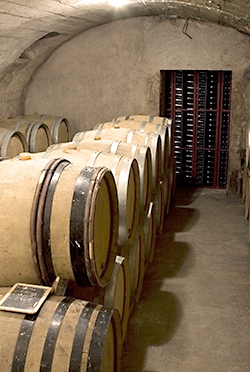Wine Making
Wine Making
Like man, wine is born with an initial potential, the equivalent of a genetic heritage, which will constitute its capacity to evolve over the years. This potential is contained in the grapes.
Part of the harvest is vinified in oak barrels in order to reinforce the richness of the fractions and the aromatic complexity. The other part is vinified in small enamelled vats to enhance the purity of the terroirs. The contents of each vat are clearly identified by the parcel of land and the racking is carried out under conditions that are in keeping with Maria THUN's lunar calendar.
The first fermentation (or alcoholic fermentation) takes place. The yeasts are selected by Françoise Bedel from yeasts naturally present in her grapes. These yeasts "eat" the sugar and thus produce alcohol and carbon dioxide, as well as other components that build the sensory characteristics of the wine.
Blending
Like a painter chooses his pigments. Like a composer writes a symphony where different instruments blend together. Like a florist imagines a bouquet by combining shapes and colours. Like a nose creates a perfume of essences from the four corners of the world. Françoise BEDEL assembles these different wines to create a new vintage each time.
Geology, exposure, place of origin and parcels contribute to this birth. It is by marrying wines with different aromatic and organoleptic qualities that she proceeds with the blending.
This approach is a constant search for a particular harmony between the notes.
Several tastings take place in October and May (according to the lunar and planetary calendar of "Maria Thum" Day/Fruit) in order to follow the evolution of the wines and also to become familiar with them.
From tasting to tasting, they are memorised, as are the reserve wines that will make up the future blend. Tasting calls upon the senses: Sight appreciates the colour of the wine, smell perceives the fruity, floral, woody or spicy notes of the aromas, and taste senses the fleshiness, fatness, vinosity, finesse or lightness.
The actual blending is a leap into the future, it can take from a few days to a few weeks. Several tests are carried out, several opinions are gathered before proceeding with the final blends. They are irreversible and unique. They express a particular style and character of the Domaine.
Bottling
All the wines are made on the estate, but some of the vintages aged in oak barrels are bottled with a cork, an ancestral method that dates back to 1735 in Champagne. Date of the royal decree of 8 May. It provides for the application of a cork stopper tied on the neck by means of a hemp cord tied on three strands.
This operation is done by hand and is long and meticulous. This bottling is determined by Maria THUN's lunar and planetary calendar in fruit days: the wine being only the extension of the grape.
This is followed by the setting of the foam and maturation on the lees, thanks to the second fermentation (in the bottle), the wines become effervescent.
Dosage and Disgorgement
Before disgorging, all the wines are tasted blind to find the best sugar/acid balance. All our riddling and disgorging operations are done manually.
The final touch before corking is the dosage, which consists of a very slight addition of expedition liqueur. As soon as the dosage is complete, the wine is corked to begin a new stage in its ageing process.
The cork stopper, held in place by a worm, ensures a maximum of watertightness but does not totally prevent gas exchange. A moderate oxidation allows the wine to continue its evolution.
Françoise BEDEL Champagnes are all aged for several years to allow time for each one to reveal its aromatic complexity.












